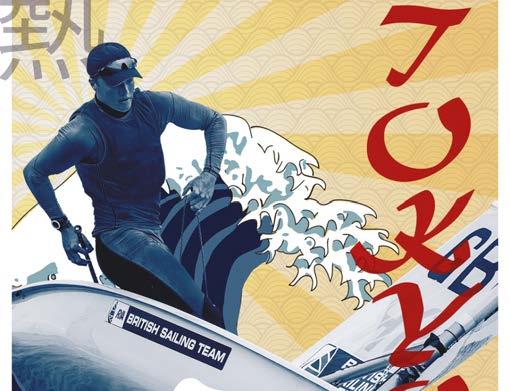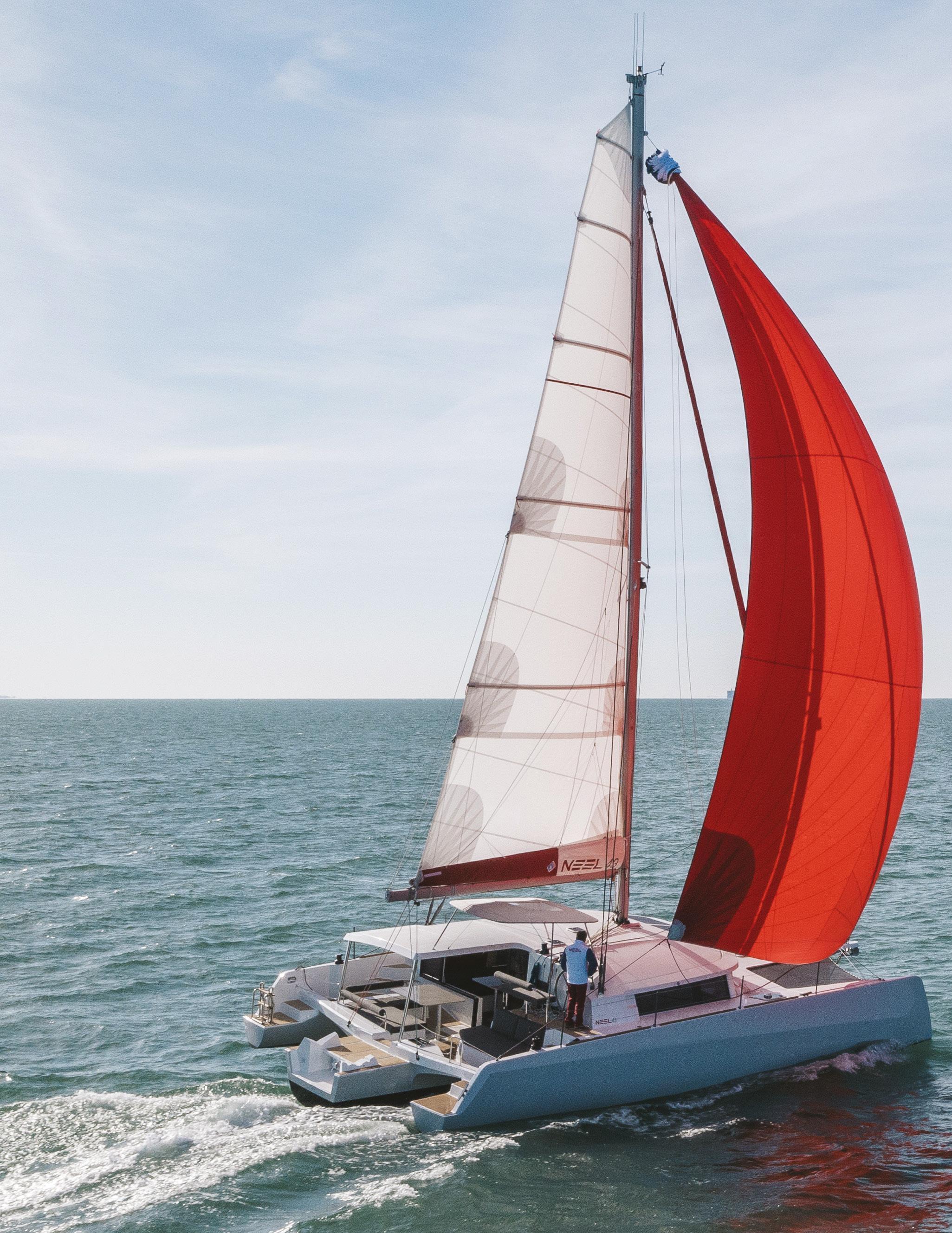
10 minute read
Neel 43
Three – that’s the magic number?
Neel trimarans have been ploughing a fairly lonely furrow with their range of cruising trimarans but the results are compelling as Sam Jefferson discovered
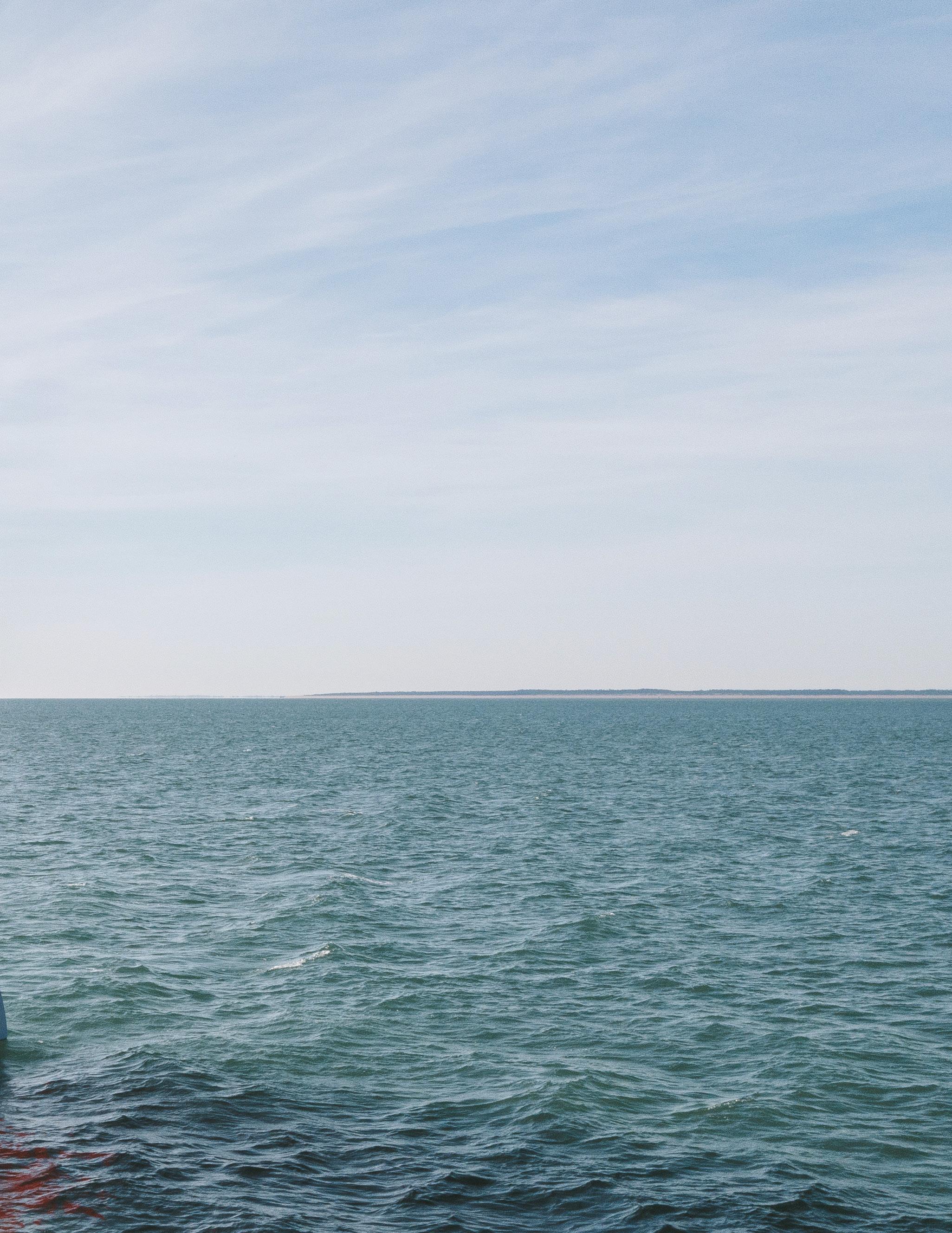
It’s not often you step aboard a yacht these days and mutter ‘hmm, different’ but I can honestly say that the Neel 43 had that effect on me. On one level, this is far from a surprise because, unlike 95% of the boats I have tested, the Neel 43 features three hulls instead of one or two. Yet there is more to it than that.
The La Rochelle based manufacturer started out with a concept that dared to be different when it first started started building cruising yachts and this has led to concept that has evolved in a different way to other boats in ostensibly the same category.
This is interesting because the goal is ultimately the same; to produce a well mannered, comfortable easy to handle sailing yacht with decent performance that you can cruise across oceans.
And, of course, a trimaran is a good vehicle for this; three hulls provide more inherent stability than a catamaran while also providing a similarly spacious platform for living aboard. The main reason that catamarans have exploded in popularity compared to trimarans is simply because building three hulls instead of two brings with it greater cost and a slightly more nuanced approach to building. This is where
Neel has excelled; building up a range of cruising trimarans with a strong reputation for performance and comfort. The Neel 43 is their latest model and is the smallest boat in their range, sitting below the 47 and replacing the old Neel 45 which hit the water back in 2012. The new 43 is designed by Marc Lombard who has worked with the company for a number of years. It sticks to the same template as the 45 in terms of an almost identical displacement and similar sail area but features many refinements on the Joubert/Nivelt designed 45.
So what have we got here? The
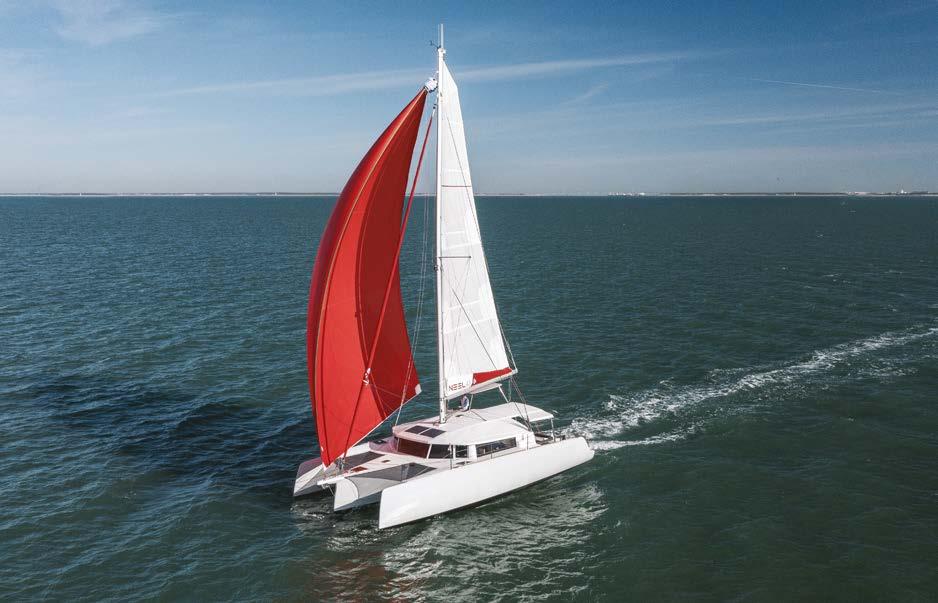

ABOVE
xx
BELOW
xxxxx 43 is, predictably, 43 ft long with a beam of 24’6”. Displacement is 9,000kg which is relatively modest for a blue water cruiser and there has been a conscious effort to make sure weight is kept to a minimum. The hull is vacuum infused sandwich with carbon fibre reinforcement. Neel has made a conscious effort to use PET as the filling for its sandwich because this is both more environmentally sustainable and also less susceptible to water infiltration. The sandwich construction and network of bulkheads also ensure that the 43 is unsinkable. The central hull is heavily rockered to facilitate fast tacking and there is a small skeg in front of the rudder that protects the saildrive and rudder. Water and fuel tanks are located low within the central hull with the 50hp sail drive located aft; all this makes for good integral stability. The sponsons are relatively narrow with aggressive dreadnought bows.
The rig is set well aft with a big fully battened main and generous overlapping genoa hinting at a boat that should be able to provide not only comfort but a few thrills along the way. The big gennaker adds another string to the 43’s bow.
The nacelle is the key to this
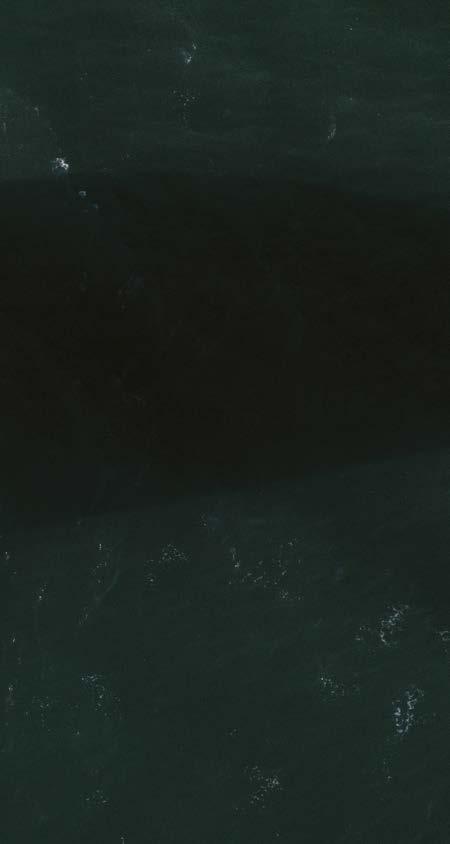
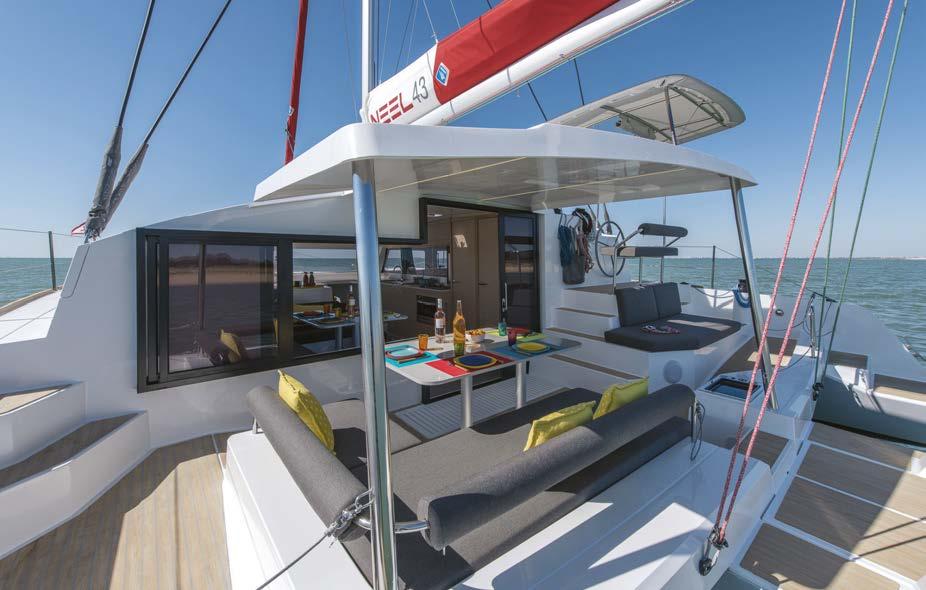
yacht’s cruising comfort and fights the battle that all multihulls have between providing masses of internal volume while not looking like a shed unsubtly dropped on top of the hulls. I’d say Neel has fought the good fight here, because, while I would argue that there are few cruising multihulls out there that would win a beauty contest, this one looks integrated and very much part of the original design concept – not always the case unfortunately.
On deck
Step aboard and you immediately think ‘well, here’s something different’ and I don’t mean that in a bad way. Neel's concept of cruising comfort revolves around the slightly unusually monikered ‘cocklit’ this is the easy transition between indoor and outdoor space common to multihulls. On the Neel the outdoor section is extensive with a solid fixed bimini providing good protection from the elements. To port is a large seating area with a table and to starboard is an aft facing bench seat which was very comfortable. The aft end of the main hull is used as a space to store your dinghy. The helm is situated to starboard and slightly raised but you do remain reasonably well in touch with the main cockpit area. The running rigging set up is relatively simple with all lines led to a bank of jammers within reach of the helmsman. From here the helm has a pair of winches, one electric and one manual on the test boat, which allow you to handle the boat with ease singlehandedly. There are two more winches on the sponsons which can be used for setting the gennaker. Up forward, the side decks are wide. You can lounge on the coachroof but there is a feeling it is not the main intention of this space which, if anything, feels a bit surplus to requirements although it’s a great spot to put acres of solar panels.
ABOVE
xxxx
BELOW
xxx
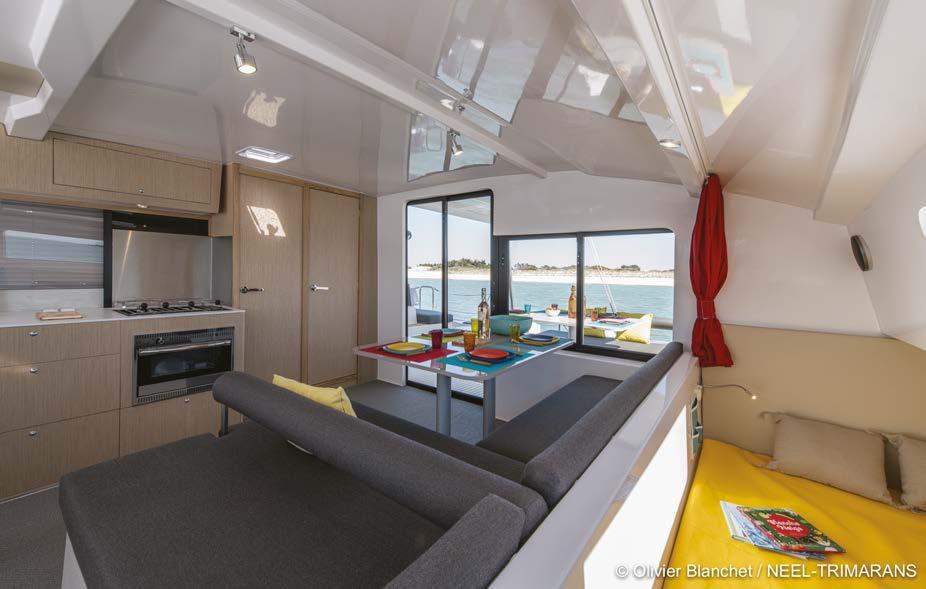
Inside/outside
The transition between saloon and cockpit is seamless and obviously all on one level. The 43 features huge forward facing windows in the saloon and these mean that this is a spectacularly bright space. There is a bit of flexibility when it comes to layout of course but on the test boat there was a main living area to starboard set well forward with the main lounging area to port. This can be converted into a double berth if you wish. Forward of this is a nav area from where you can happily control the boat thanks to the autopilot and the excellent views forward. To port and starboard are a pair of double berths which are very bright thanks to internal windows letting light in and making them very much part of the communal space by day, while curtains ensure you have your privacy at night. The heads/shower room is on the
starboard side aft of the galley and the main stateroom is in the bow of the main hull. In addition, there are two small single berths in the bows of the two sponsons that can be accessed from the main deck. Never before have I used the word labyrinthine on a boat test, but I have to say that there were moments when the Neel had me foxed. I was also charmed by the whole approach to the interior design. There is a clear emphasis on weight saving and this is reflected in the use of fabrics instead of doors for cupboards and a simplicity to the layout. Yet that does not mean it is sparse or cold – far from it. The use of bright colours for fabrics and all that natural light make for a friendly environment. I was somehow put in mind of Playschool with all those bright primary colours. It was cheerful and made you think of holidays. Access to the engine area was good and there was a lot of space beneath the deck for all manner of blue water kit. My only real reservation was that I felt the heads/ shower area was a bit tunnel like.
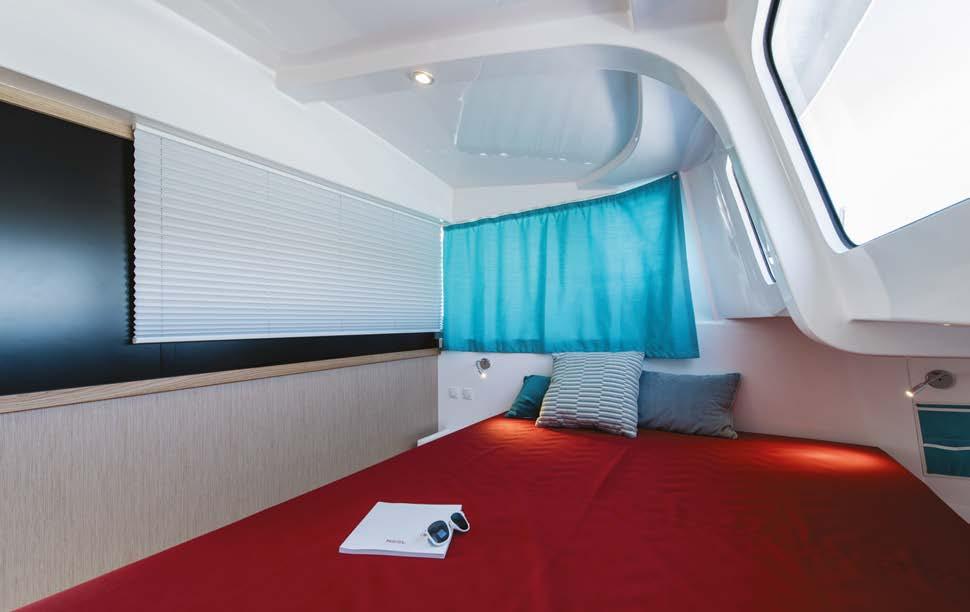
Under sail
The next question was, how would the damn thing sail? Well, I’m happy to say that the answer is that it went very well indeed. There is always something ponderous and stately about these big multihulls as you move away from the pontoon berth. You feel like you’re at the helm of a block of flats or a cross channel ferry and I must admit I’ve sailed a couple that handled similarly. This is definitely not a charge that could be levelled at the Neel. We sailed in a pretty steady 10-15kn of breeze and flat water and the boat behaved exceptionally well. Straight line speed was superb – rarely dropping below 10kn. What struck me most was the consistenct of the boat. It stuck to that 10kn with some rigidity. You had to try pretty hard for the speed to drop below that and in the puffs there were some nice surges of acceleration.Being a trimaran, there is a bit more involvement than on your typical cruising cat. The intention is to fly the windward hull and this means there is a decent amount of heel – not enough to
ABOVE
xxx
BELOW
xxxxxx scare anyone but enough to make you feel you are sailing with purpose. The steering also had great feel and this is achieved by having a single rudder controlled by Vectran lines on ball bearing blocks.
At the helm you felt fully in control of the boat and I was impressed by how close winded the 43 was. This is also a boat that went through the tacks with relative ease, although the real test would have been in choppier waters. I was slightly taken aback by the fact that one winch was used to control both jib sheets, meaning that mid tack there is a bit of a scramble to switch them over. Although a pair of cleat jammers reduces this issue and we certainly had no problem on the test day to be fair. The only other thing of note was that we really did sail fast and with a great feeling of speed – obviously a joyous thing – on the flip side we did also manage to receive a decent lump of spray into the cockpit as a result of this impressive speed. This may have been just an unfortunate occurrence but it would be good to sail the boat in wilder seas.

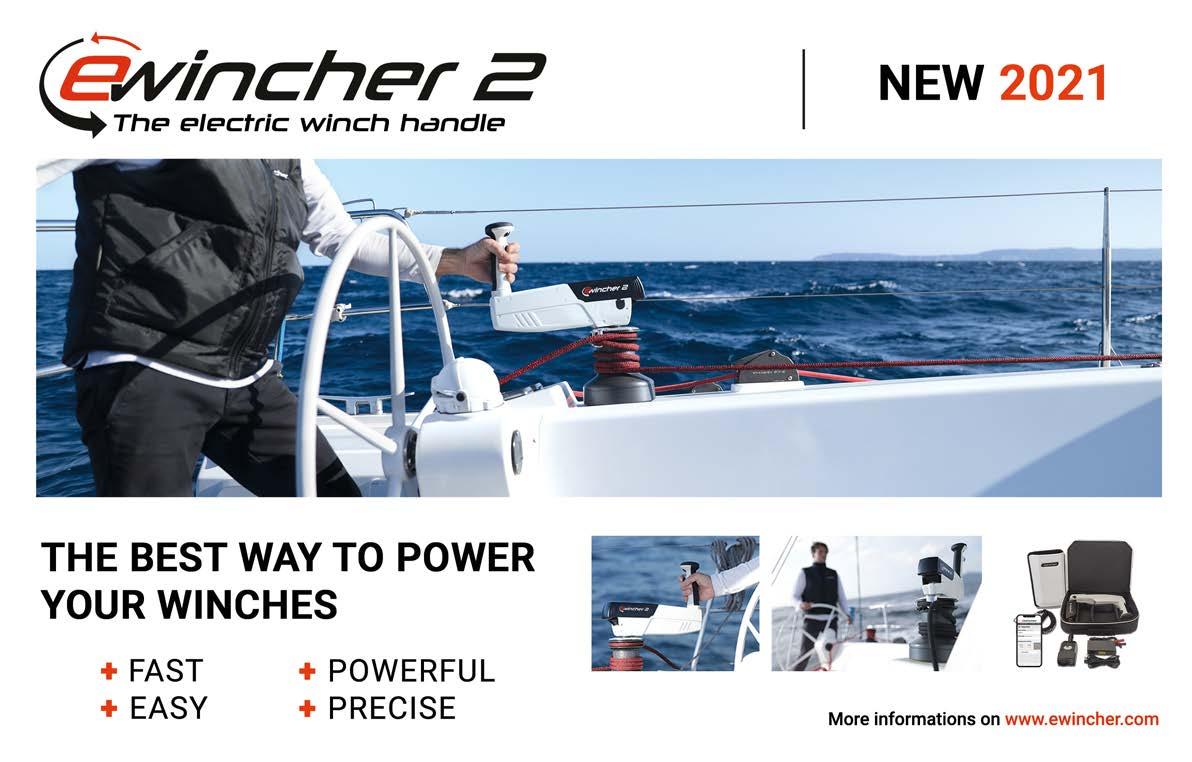
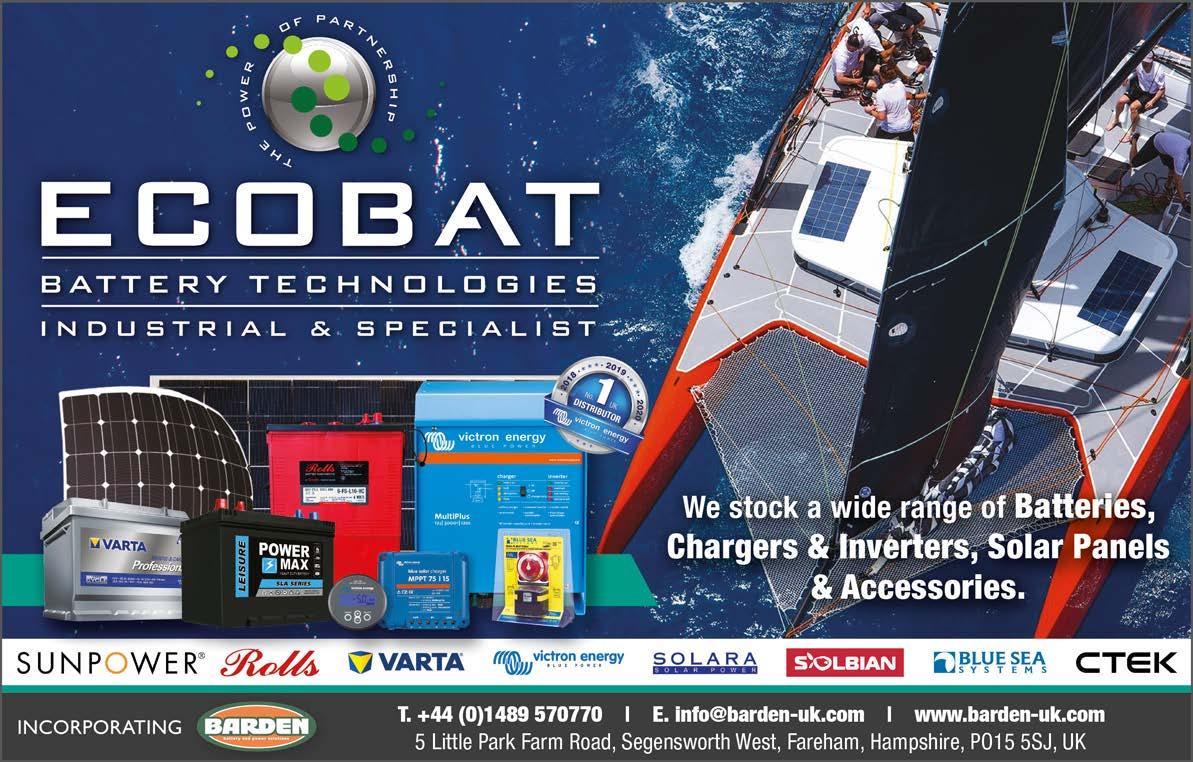
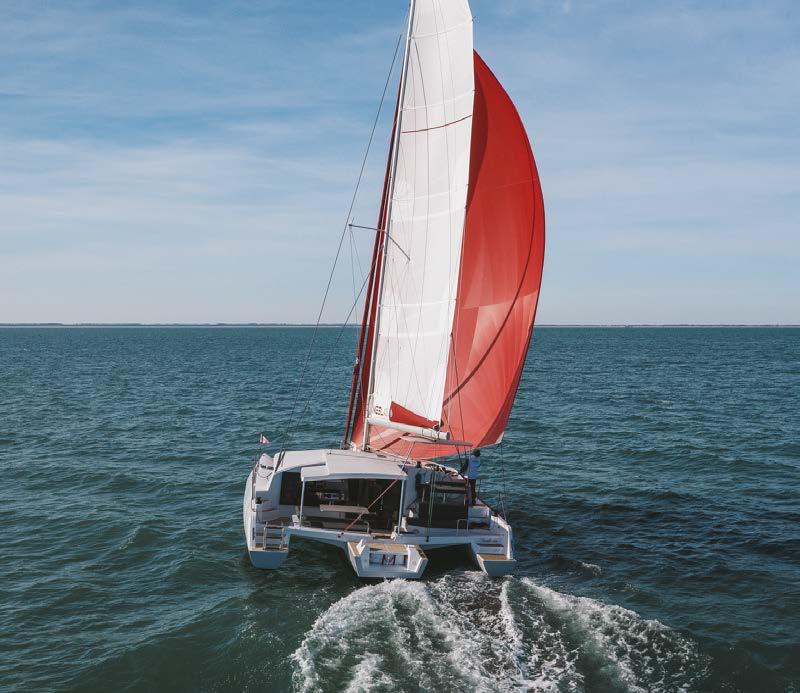
SAM’S VERDICT
e Neel 43 is a highly innovative yacht that combines weight saving and sleek hull design with clever nacelle layout to provide a yacht that is both fast, fun and comfortable. e looks are individual – as with most multihulls – but the performance is undeniable – not always the case with multihulls. It’s a boat that will doubtless appeal to someone with a very clear idea of what they want from a yacht and someone who dares to be a bit di erent. As such, I thought it was excellent and a real beath of fresh air.
PERFORMANCE: ★ ★ ★ ★ ★ LOOKS: ★ ★ ★ ★★ COMFORT: ★ ★ ★ ★★
THE SPEC
Length: 42’7” (12.97m) Width: 24’6” (7.49m) Draught: 4’5” (1.37m) Displacement: 9,000kg (19,800lbs) Sail area: 1096 sq/ft (101.8m/2) Engine: Diesel Sail drive 50HP Price: (base) €329,800.00 (VAT not paid) Contact: neel-trimarans.com Multihull.co.uk (UK Dealer)
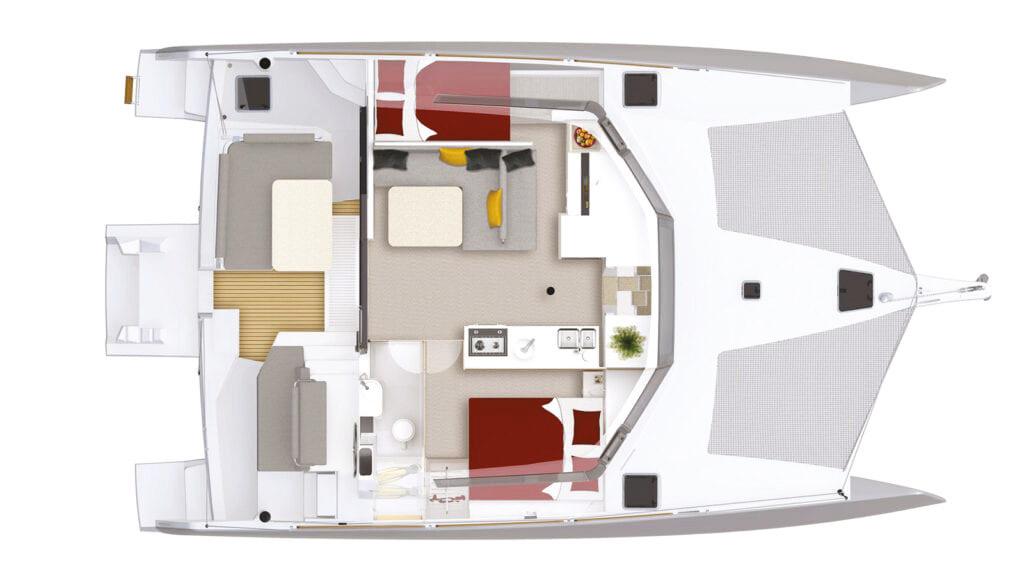
ALTERNATIVE BOATS
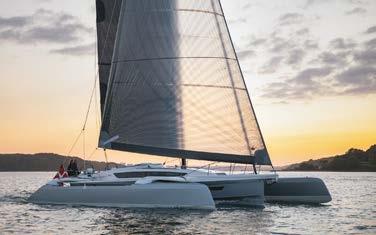
DRAGONFLY 40
A bit smaller and sportier but with less volume. Danish boatbuilder Dragon y has been ploughing a similarly individual furrow and this is their biggest o ering yet. dragonfl y.dk
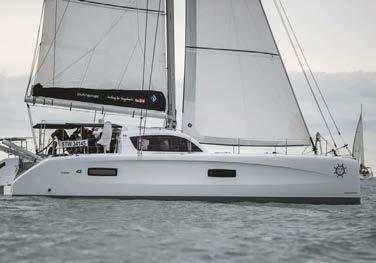
OUTREMER 45
Ok only two hulls not three but this is a catamaran with a similar blend of performance and comfort in a very attractive looking multihull. catamaran-outremer.com
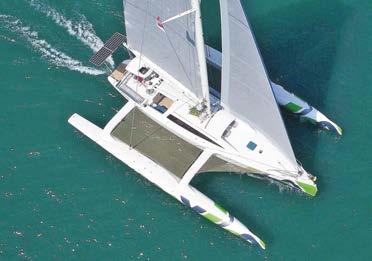
RAPIDO 50
A bigger boat and an interesting proposition, claiming to be the world's ‘ultimate folding ocean cruising trimaran’. Hard to argue with that. rapidotrimarans.com
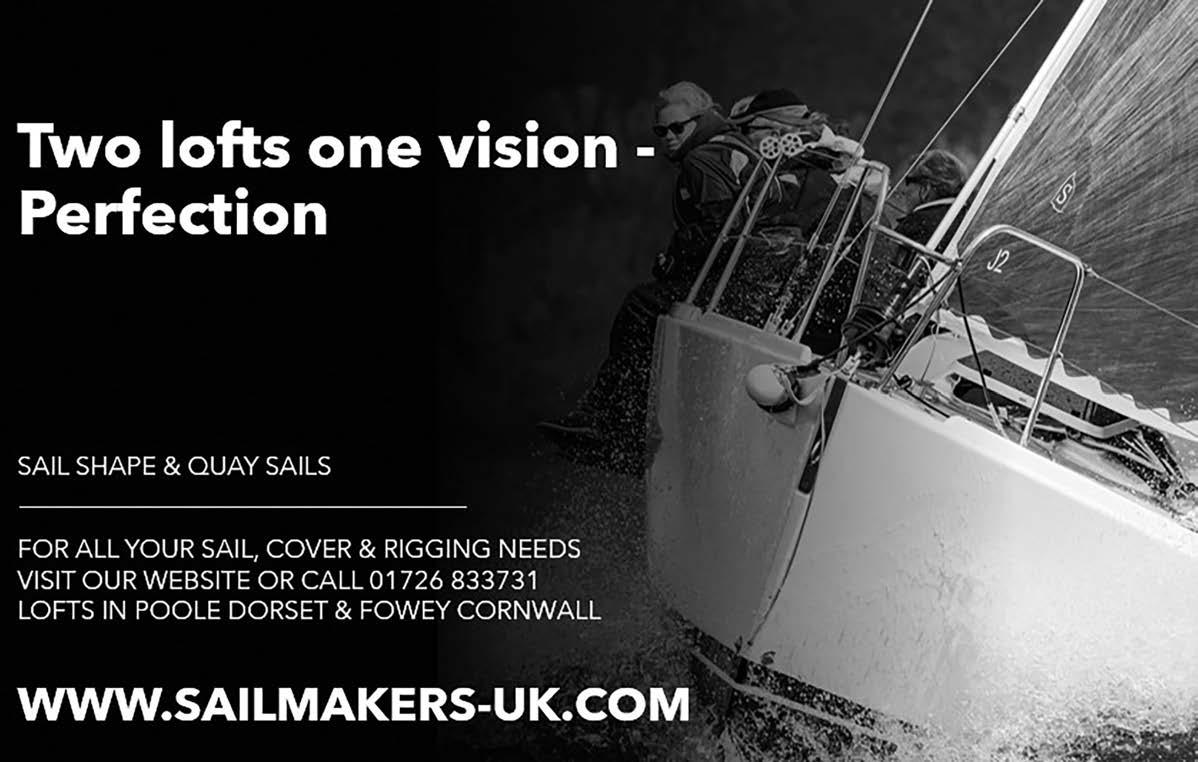
94 years of experience in yacht refit, repair & restoration
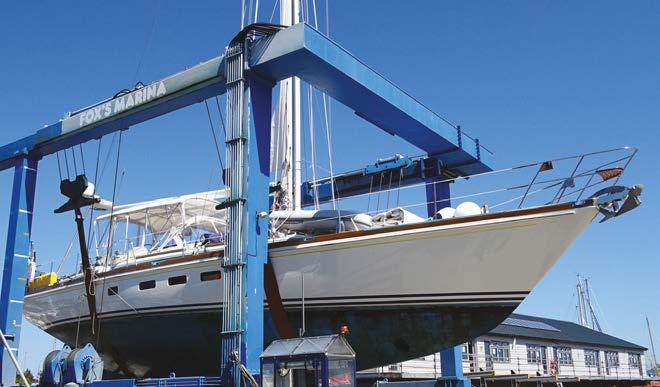

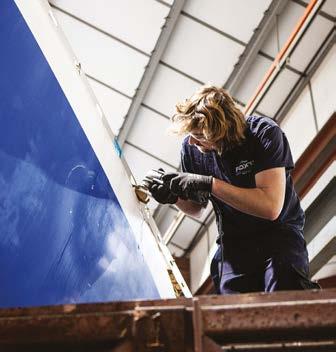
The UK’s leading yacht refit and repair facility
The complete service for all racing, cruising and motor yachts under one roof
Traditional yacht repairs & joinery Sprayshop & hull finishing Marine engineering & electronics Spars, rigging, ropes & splicing GRP repair & modifications Stainless repair & fabrication Bluewater cruising & race preparation
Fox’s Marina & Boatyard, Ipswich, Suffolk, IP2 8SA +44 (0) 1473 689111 foxs@foxsmarina.com foxsmarina.com





